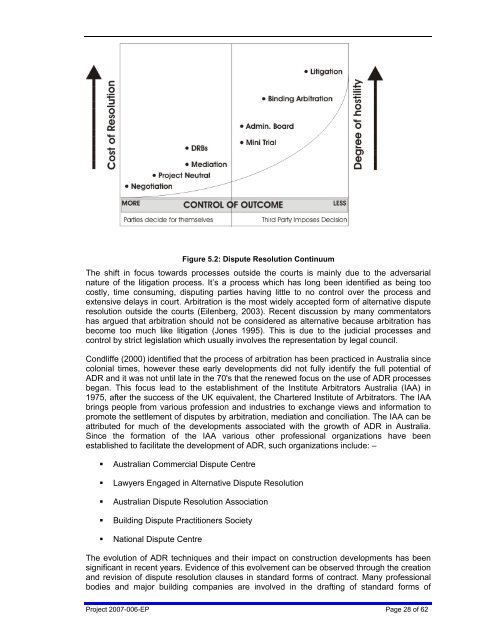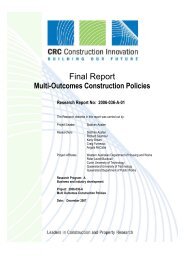Dispute Avoidance and Resolution (literature review) - Construction ...
Dispute Avoidance and Resolution (literature review) - Construction ...
Dispute Avoidance and Resolution (literature review) - Construction ...
Create successful ePaper yourself
Turn your PDF publications into a flip-book with our unique Google optimized e-Paper software.
Figure 5.2: <strong>Dispute</strong> <strong>Resolution</strong> ContinuumThe shift in focus towards processes outside the courts is mainly due to the adversarialnature of the litigation process. It’s a process which has long been identified as being toocostly, time consuming, disputing parties having little to no control over the process <strong>and</strong>extensive delays in court. Arbitration is the most widely accepted form of alternative disputeresolution outside the courts (Eilenberg, 2003). Recent discussion by many commentatorshas argued that arbitration should not be considered as alternative because arbitration hasbecome too much like litigation (Jones 1995). This is due to the judicial processes <strong>and</strong>control by strict legislation which usually involves the representation by legal council.Condliffe (2000) identified that the process of arbitration has been practiced in Australia sincecolonial times, however these early developments did not fully identify the full potential ofADR <strong>and</strong> it was not until late in the 70's that the renewed focus on the use of ADR processesbegan. This focus lead to the establishment of the Institute Arbitrators Australia (IAA) in1975, after the success of the UK equivalent, the Chartered Institute of Arbitrators. The IAAbrings people from various profession <strong>and</strong> industries to exchange views <strong>and</strong> information topromote the settlement of disputes by arbitration, mediation <strong>and</strong> conciliation. The IAA can beattributed for much of the developments associated with the growth of ADR in Australia.Since the formation of the IAA various other professional organizations have beenestablished to facilitate the development of ADR, such organizations include: –• Australian Commercial <strong>Dispute</strong> Centre• Lawyers Engaged in Alternative <strong>Dispute</strong> <strong>Resolution</strong>• Australian <strong>Dispute</strong> <strong>Resolution</strong> Association• Building <strong>Dispute</strong> Practitioners Society• National <strong>Dispute</strong> CentreThe evolution of ADR techniques <strong>and</strong> their impact on construction developments has beensignificant in recent years. Evidence of this evolvement can be observed through the creation<strong>and</strong> revision of dispute resolution clauses in st<strong>and</strong>ard forms of contract. Many professionalbodies <strong>and</strong> major building companies are involved in the drafting of st<strong>and</strong>ard forms ofProject 2007-006-EP Page 28 of 62
















